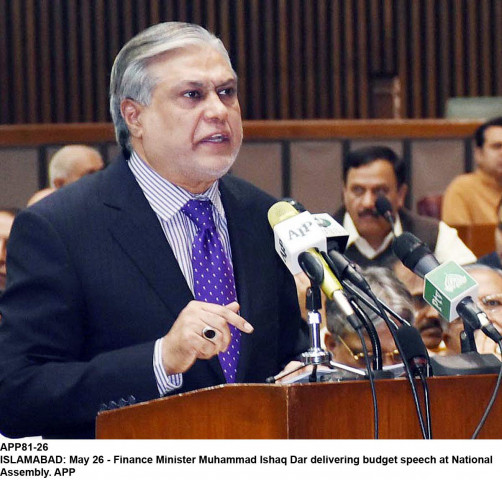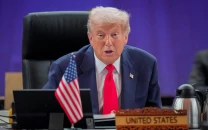Pakistan Economic Survey – ups and downs
Total debt has risen to Rs20,872 billion compared to Rs14,318 billion in 2013

Total debt has risen to Rs20,872 billion compared to Rs14,318 billion in 2013. PHOTO: APP
This increase in the overall size of the economy indicates improved productivity and better standards of living. Since an estimated one-third or more of Pakistan’s economy is undocumented and so does not form part of the Gross Domestic Product (GDP) figures, the actual economic growth is probably higher.
The government can rightly claim some credit for this, although this growth falls short of the target of 7.2% that it had set for itself three years ago. This is still far lower compared to neighbouring countries in South Asia such as India and Bangladesh, which are growing at around 7%.
Looking at the sub-components of growth, there is good news from agriculture, which showed a positive growth of 3.5% versus actual contraction of 0.27% last year. This change may be attributed to a 3.02% growth in crops (cotton, sugarcane, maize and gram) against a negative growth of 4.97% last year.
Tourism conference: Coherent strategy needed to build tourism economy
The government’s active attention to this sector through the Prime Minister’s Agriculture Kisan Package and increased disbursement of Rs700-billion credit may have helped the turnaround. However, the performance of industrial sector, with a growth of 5% against the target of 7.7% in 2016-17, is not very encouraging. Despite some bright spots such as those related to construction industry (iron and steel and cement), other key sectors such as fertilisers and engineering products were almost stagnant.
Growth of services (5.98%) is mostly because of banking and insurance, which grew 10.77%.
Similarly another sector, government services, showed a growth of 6.91%. While the growth in government services indicates increased expenditure and as such is not a healthy sign, the growth in the banking sector means higher deposit mobilisation, which is a positive indicator.
Tax policies
There is slight improvement in government’s taxation policies towards telecom and mobile phone sector. This would, to some extent, balance the negative fallout of the anti-telecom policies followed over the last four years. Hopefully, this will once again make Pakistan an attractive market for foreign investors.
According to the State Bank of Pakistan, in the last nine months, the FDI decreased $82 million. The government is finally realising that when its policies were favourable to this sector, it flourished and attracted FDI of approximately $5.7 billion (net).
'Economy will prosper through industrial activity, innovation'
Furthermore, Pakistan’s high growth from 2003 to 2007 had a lot to do with liberalisation during that period.
Total debt has risen to Rs20,872 billion compared to Rs14,318 billion in 2013. Thus, during the last four years, the debt has risen by almost 50%. Already this year, interest payment on debt was the largest single expense for the country.
Next year Pakistan’s external debt servicing is estimated to be 25% higher than a year ago, which was $5.3 billion. It seems that increased spending on debt servicing will continue to be a major drag on the economic growth for years to come.
Another worrying development is the continuous fall in exports since the PML-N government came to power. In the first nine months of the current year, there was a further decline of 3.06% with exports volume shrinking to $15.119 billion.
The finance minister normally avoids speaking about exports as if this is irrelevant to the economy. What he has to realise is that this significant fall in exports has been one of the biggest failures of this government.
There may be many reasons for this poor performance but the most obvious one is the anti-export bias in the tax policies. With every budget for the last four years, the finance ministry has been increasing taxes on international trade either to curb imports or raise higher revenue. These policies have isolated Pakistan from international markets with the result that the country’s exports have fallen.
With the widening of fiscal deficit, slowing down of remittances and foreign direct investments and increasing circular debt, the government may find it difficult to keep the economy afloat without more borrowing.
Furthermore, it is not likely that during the forthcoming election year, the government would maintain the ongoing reform process, which has been steady, even if slow. All these factors may result in the next government having to face serious economic challenges.
The writer served as Pakistan’s ambassador to WTO from 2002 to 2008
Published in The Express Tribune, May 29th, 2017.
Like Business on Facebook, follow @TribuneBiz on Twitter to stay informed and join in the conversation.



















COMMENTS
Comments are moderated and generally will be posted if they are on-topic and not abusive.
For more information, please see our Comments FAQ